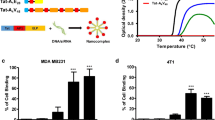Abstract
Some growth factor receptors, such as insulin like growth factor I and II receptor (IGF I R, IGF II R) and epidermal growth factor receptor (EGF R), have been proved to be over-expressed in a variety of human cancers derived from different tissue origins. Based on this molecular alteration, a polypeptide conjugate gene delivery system was designed and synthesized. It contains three essential moieties: a ligand oligopeptide (LOP) for receptor recognition, a polycationic polypeptide (PCP) such as protamine (PA) or poly-L-lysine (PL) as a backbone for DNA binding and an endosome-releasing oligopeptide (EROP) such as influenza haemagglutinin oligopeptide (HA20) for endosomolysis. These components are covalently conjugated as LOP-PCP-HA20 or in the form of a mixture of LOP-PCP and HA20-PCP. A 14 amino acid E5 was designed and synthesized as LOP for IGF I R and IGF II R, and a 16 amino acid GE7 as LOP for EGF R. Both E5 and GE7 systems could form stable complex with the plasmid DNA as E5-PCP/ DNA/PCP-HA20 and GE7-PCP/DNA/PCP-HA20. Using bacterial β-galactosidase gene (pSVβ-gal) as a reporter, the present system is able to efficiently target exogenous gene to human cancer cells of different tissue types with high efficiency bothin vitro and in implanted tumors in nude mice. It was also demonstrated that the transduced genes were highly expressed in cancer cells bothin vitro andin vivo. The present system will provide a novel effective vehicle to target therapeutic genes into cancer cells in gene therapy.
Similar content being viewed by others
References
Miller, A. D., Law, M. F., Verma, I. M., Generation of helpor-free amphotropic retrovirus that transduce a dominant-action, methotrexate-resistant dihydrofolate reductase gene,Molecular Cellular Biology, 1985, 5: 431.
McDonald, R. J., Lnkason, M. J., Raobe, O. G. et al., Safety of airway gene transfer with Ad2/CFTR2: Aersol adminis-tration in the nonhuman primate,Human Gene Therapy, 1997, 8: 411.
Walther, F. J., Uptake of antioxidants in surfactant liposomes is enhanced by SP-A,American J. Physiol., 1993, 265: 1330.
Wu, G. Y., Wu, C. H., Receptor-mediatedin vitro gene transformation by a soluble DNA carrier system,J. Biol. Chem., 1987, 262: 4429.
Wu, C. H., Targeting genes: delivery and persistent expression of a foreign gene driven by mammalian regulatory elementsin vivo, J. Bio. Chem., 1989, 264: 19685.
Cotton, M., Langle-Rouault, F., Kirlappos, H. et al., Transferrin-polycation-mediated introduction of DNA into human leukemic cells: stimulation by agents that affect the survival of transfected DNA or modulate transferrin receptor levels,PNAS, 1990, 87: 4033.
Midar, P., Mendes, C., Legrand, A. et al., Specific gene transfer mediated by lactotated poly-L-lysine into hepatoma cells,Nuc. Aci. Res., 1993, 21: 871.
Zhou, X. M., Gu, J. R., David, S. et al., Stimultaneous overexpression of insulin-like growth factor II (IGF II) and IGF II receptor genes in human primary hepatic cancer,Tumour (in Chinese), 1991, 11: 241.
Wrann, M. M., Fox, C. F., Identification of epidermal growth factor receptors in a hyperproducing human epidermoid carcinoma cell line,J. Biol. Chem., 1979, 254: 8083.
Carlsson, B. J., Drevin, H., Axen, R., Protein thiolation and reversible protein-protein conjugation,Biochem. J., 1978, 173: 723.
Stuchbury, T., Shipton, M., Norris, R. et al., A receptor group delivery system with both absolute and selective specificity for thiol groups and improved fluorescent probe centaining the 7-nitrobenzo-2-oxa-l, 3-diazole moiety,Biochem. J., 1975, 151: 417.
Xu, L., Pirollo, K. F., Chang, E. H., Transferrin-liposome-mediated p53 sensitization of squamous cell carcinoma of the head and neck to radiationin vitro, Human Gene Therapy, 1997, 8: 467.
Cristiano, R. J., Roth, J. A., Epidermal growth factor mediated DNA delivery into lung cancer cells via the epidermal growth factor receptor,Cancer Gene Therapy, 1996, 3(1): 4.
Wade, J., CDK inhibitors in development and cancer,Current Opinion in Genetics &Development, 1996, 6: 56.
Ren, C. C., Tian, P. K., Qu, S. M. et al., Expression of cyclin-dependent kinase inhibitor genes induces apoptosis in human hepatoma cell line,Chinese Science Bulletin, 1997, 42(23): 2000.
Author information
Authors and Affiliations
Additional information
Project supported by the Biotechnology Project, National High Technology Program and Shanghai Municipal Science and Technology Program.
Rights and permissions
About this article
Cite this article
Tian, P., Ren, S., Ren, C. et al. A novel receptor-targeted gene delivery system for cancer gene therapy. Sci. China Ser. C.-Life Sci. 42, 216–224 (1999). https://doi.org/10.1007/BF02880059
Received:
Issue Date:
DOI: https://doi.org/10.1007/BF02880059




